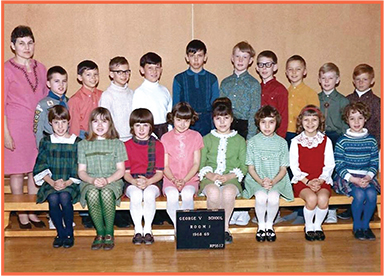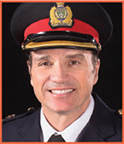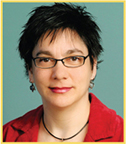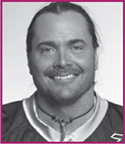MICHAEL BOSS’S STORY

In the late 1960s I was in Major Work at George V School for grades 4, 5 and 6. Mrs. Anne Moroz was my teacher. She encouraged and always expected our best efforts. Mrs. Moroz recognized my interest in art early on and took every opportunity to support my efforts.
As summer approached at the end of my final year, she asked me to paint a picture of crocuses for her. She purchased a canvas board and deluxe oil painting kit for me to use. She also gave me a greeting card with a picture of the flowers that she asked me to copy.
I had never used oil paint before, and I hummed and hawed all summer until I finally mustered up the inner resources to take on the project, knowing she was awaiting the results. I really struggled, but finally I completed the painting and in the fall I tentatively presented it to her. As I recall, the painting looked pretty rough, but it was the best I could do at the time.
Mrs. Moroz was delighted and full of compliments. She insisted that I keep the painting kit, and also paid me a commission for the painting! She told me she would frame it and place it on a wall in her home. Of course, I was thrilled with her generosity and very pleased with her reaction to the work I had done.
Over the years I lost touch with Mrs. Moroz. I graduated from Fine Arts at the University of Manitoba and went on to become a professional artist, a professor of Fine Arts and eventually, Head of Studio Programs at the Winnipeg Art Gallery.
I have always remembered the encouragement I received from Mrs. Moroz. Just last year, through a former George V classmate, I had the opportunity to re-connect and have lunch with Mrs. Moroz (She asked me to call her Anne, but to me she will always be Mrs. Moroz)! She told me the painting remains on her wall, where it has been for almost 50 years!
DAVID SANDERS’S STORY
I’d like to tell you about an influential teacher in my life. Mr. Bob Nakamura taught vocational electrical to me at Sturgeon Creek Regional Secondary School in Winnipeg from 1972 to 1975.
Although I was working on the necessary courses for University entrance, I was also enrolled in the vocational electrical/electronics program. As such I spent a majority of my class time working with and learning from Mr. Nakamura. Mr. Nakamura was a very honorable man, teaching us not only intricacies of electrical work, but the dignity of work, the satisfaction of a well done job and the contribution that we could make to our community and society.
I’ve carried those lessons through my life. I went on to graduate from electrical engineering and worked on large electrical power projects in support of the electrical grid throughout North America and the World. Publicly the nature of my work has been to be in the shadows, secure in the knowledge that I’ve helped keep people warm, secure and safe in their homes and businesses. Although I went on to higher education, my work has always had the foundation of those basic electrical lessons taught by Mr. Nakamura.
I’ve mentored many young engineers and technicians and can only hope that I instilled in them the societal lessons which I learned from Bob Nakamura. Mr. Nakamura died in 2003 and I regret that I never took the time to look him up and thank him personally for his influence in my life and career. I thank the Manitoba Teachers Society for the opportunity to share this story.
It seems appropriate to close this remembrance with a quote from Stephen Leacock, “I owe a lot to my teachers and mean to pay them back some day.”
ANDREW HARRIS’S STORY

Andrew Harris may have fumbled his football career had it not been for one of his high school coaches.
The Blue Bombers star running back moved to Winnipeg from Steinbach after being recruited to play for gym teacher and head football coach Stu Nixon at Grant Park High School.
However, before Harris arrived for Grade 10, Nixon left to coach the Oak Park High School squad.
Harris rolled with the change, at least on the gridiron.
“I was excelling on the field and off the field not so much,” he says.
He describes falling in with the wrong crowd in grades 10 and 11, skipping school and partying too much on the weekends.
Nixon had been watching him from afar and convinced Harris to attend Oak Park for Grade 12.
“Mr. Nixon took me under his wing, he got me familiar with the school and kind of just guided me through my senior year.”
“I just needed a little guidance and I didn’t quite get that at home so he was there to kind of guide me along through that.”
It’s those types of connections he believes are “crucial” for students.
“A lot of times, whether it be money or encouragement or confidence, there’s things that kids lack. And it’s not just about sports,” he says.
“There’s so many other things people can be exposed to and be a part of, but maybe they’re not getting the confidence or push at home.
“That’s where teachers can see a certain area a student may excel in and maybe just give them that extra confidence and that extra boost to go into it and give a helping hand along the way.”
NICOLE BARRY’S STORY

Entrepreneurs usually have to be disciplined and confident in reaching their goals.
Nicole Barry has those traits, thanks in part to her Grade 11 English and German teacher at John Taylor High School, Frau Klassen.
The owner of PEG Beer Co. credits Klassen with giving her “guidance, support and consistency” in 1995 when she was struggling at home.
“She showered me with praise when earned and worked with me to improve where needed,” Barry recalled. “She did so with every single student, not just me.
“She taught me self-discipline, which I’ve carried with me throughout my life. It aided me through the challenges of obtaining my CPA, CGA and becoming an entrepreneur. Danke, Frau Klassen. Prosst!”
Barry became a founder and co-owner of Half Pints Brewery, but embarked on her own and opened PEG Beer Co. last year, a popular brew pub in Winnipeg’s Exchange District.
And now her son is benefitting from one of his teachers at Sansome School.
He was diagnosed with juvenile arthritis and missed a lot of school this year as doctors tried to find the right mix of medications.
“Mrs. Chase has always been a kind resource for our family over our years at Sansome, but this year stands out,” Barry says.
“Her compassion, understanding and resourcefulness have been so amazing. We are lucky to have her as a part of my son’s journey as we all adapt to this new way of life with his chronic disease.”
DANNY SMYTH’S STORY

The teenage years are often filled with anxiety and questions as young boys and girls try to find out where they fit in the world.
It was no different for Winnipeg Police Chief Danny Smyth.
When Smyth attended Chief Peguis Junior high from 1977-79, his Grade 9 homeroom and English teacher Barbara Simmons took on an informal role of guidance counsellor.
She made a big impact on him by helping to alleviate a lot of his stress and confusion.
“I remember going through a lot of changes,” Smyth says. “I was changing physically and emotionally, and I was starting to really explore the world around me and to understand my identity and place in the world.
“Ms. Simmons made herself available to talk. She helped me put perspective on things that were concerning to me and helped to normalize my feelings.”
Smyth also fondly recalled two other teachers that influenced him.
Mr. Reimer at Princess Margaret Elementary School was his first male teacher and a role model, while Leon Pewarchuk at then-Kildonan East Regional Secondary School taught him to appreciate art.
JENNY GERBASI’S STORY

When Jenny Gerbasi graduated from Argyle Alternative High School in 1980, she was one of seven students to reach that milestone.
It was the inner-city school’s small population that made it a special place to learn, the Winnipeg city councillor (Fort Rouge-East Fort Garry) said.
“It was a very small school so it was a fairly close atmosphere and everyone was on a first-name basis with the teachers,” said Gerbasi, who went to the school for Grade 12.
She’ll always appreciate the support she received from math teacher Charles Polcyn, English teacher John Blewett and history teacher Ron Kirbyson.
“All three of those people, I’m still in contact with,” said Gerbasi, who’s been a city councillor since 1998.
“They were all just really unique, dedicated, caring individuals … One thing I remember about (Kirbyson) was he actually wrote history textbooks.”
Some students attended Argyle because they didn’t fit into the regular school system, she said. She’d left home in Grade 12 because of family issues and was seeking a school with a “supportive, sensitive environment.”
“(Argyle had) an atmosphere of feeling accepted and loved, which so many kids need at that age,” she said.
“(Those three teachers) all believed in me, and I’m sure in the other students as well. You just felt that they saw you as an individual. They saw the value in you.”
She’ll never forget her graduation. School administrators found some extra money and the graduates went out for dinner at the Keg and Cleaver restaurant – the school’s first graduation dinner.
“I recall reading a speech out and I had written it out on a roll of toilet paper,” she said with a laugh.
“One of the things I remember saying was how I was kind of scared, not wanting to leave this environment, this safe place.”
Gerbasi went on to graduate with a nursing degree from the University of Manitoba in 1986. She was a nurse with VON for 11 years and also taught nursing at the U of M.
GAIL ASPER’S STORY

When Gail Asper is asked to recall a teacher who had an impact on her life, she begins at the beginning.
“When you are starting out in life, first impressions are extremely important and, thanks to Miss Holbrow, my first impression of grade school was wonderful,” Asper says of her Grade 1 teacher at Robert H. Smith School.
“Miss Holbrow was beautiful, kind, smart and funny. I can still picture entire scenes with her in our classroom, even though it is now nearly 40 years since she taught me!”
One time, Asper recalls, some girls were caught playing with their Barbie dolls in class.
“Instead of getting mad, (Holbrow) showed child-like delight at the new fangled twist-and-turn, bendable legs of the new Barbies and noted that her legs made a funny cracking noise when she bent them, just as the Barbie’s legs did when you bent them,” Asper says.
“She then did a deep crouch just to show how she had cracking knees, too. I think from then on I thought she was part Barbie because she also looked as beautiful as the Barbies.”
One day, when the Lord’s Prayer was being said, a boy stuck up his hand and shouted, “Miss Holbrow – Gail didn’t close her eyes during the Lord’s Prayer.”
“I thought I was in horrible trouble and turned beet red at this true accusation,” Asper says. “Without skipping a beat, Miss Holbrow coolly looked at my accuser and said, ‘Well, I guess your eyes must have been open, too, or you wouldn’t have been able to see Gail with her eyes open.’
“That boy never uttered an accusation again against me and my admiration for Miss Holbrow was forever committed.”
When school was over, she remembers walking home, crying because the school year was finished.
“In fact, I distinctly recall vowing that Wednesdays would forever be a day of mourning in my life because it was on a Wednesday that I had to say farewell to my dear, beloved Miss Holbrow,” she says.
“But thanks to her wonderful year of teaching and encouragement, I went on to enjoy many more years of school at Robert H. Smith and enjoyed running into her over the years as she grew older, got married, had kids and continued inspiring others.”
“So whenever I see purple and yellow together (which is often) I think of him,” Asper says. “He also had the best saying, which I use all the time – ‘What you abuse, you lose.’ “
TROY WESTWOOD’S STORY

“My favourite teacher of all time was Mr. Small, my Grade 5 teacher at Royal School in Winnipeg. He had a remarkable relationship with each kid in his class.
He read to us The Hobbit from Tolkien and planted a seed for that type of fantasy, which later led to me reading all the Lord Of The Rings and enjoying Dungeons And Dragons.
He took our entire class to see Close Encounters of the Third Kind. I remember how excited the whole class was on the way to the film.
He also allowed our class to take care of some gerbils. We had a family or two.
I remember the talks he would have with us. He was great at nurturing young minds — getting us to think, and dream.
I saw him a few years ago and thanked him.”
SAM KATZ’S STORY

Being a young Jewish boy growing up in the North End wasn’t always easy, Sam Katz recalls.
Like the many times he and his friends were the target of bullies.
“I remember myself and another student, almost every day a bunch of other guys would start a fight with us,” Katz says.
“Not that we were doing anything, they would just start a fight. Every day when this happened, we wouldn’t run away, we’d fight.
“Most we’d lose, some we’d win, but the end result – after getting a lot of abuse from my mother for breaking my glasses in all of these fights – was in some strange way they gained respect for both of us and it stopped. I guess because we never backed down.”
One of the reasons Katz stood up for himself was because of the guidance he received from Mr. Redekopp, his Grade 7 teacher at Edmund Partridge Junior High School in West Kildonan.
“I was growing up in the North End in the early ‘60s and it was a melting pot and not everybody got along with everybody,” Katz says.
“(Redekopp) sat down with me and tried to explain it (prejudice). He said, ‘Hey, I understand what you’re going through and it happens. You have to learn to deal with it. And if you deal with it, you can take a liability and turn it into an asset.’
“He taught me to stand up for what we believe in. He was just a great teacher.”
Redekopp, who was Mennonite, invested a lot of energy and time in students, Katz adds.
“I’m not talking about just in the classroom, I’m talking about outside the classroom as well. I think it showed me and everyone that he genuinely cared about us at that point, he genuinely cared about our future and he understood that getting an education was important to us.”
He also instilled in Katz the belief school could be a combination of fun and work.
“I regret I never kept in touch with him,” Katz says.
CLARA HUGHES’S STORY

Before Clara Hughes began her journey to the Olympic Games, she attended Elmwood High School.
Well, she didn’t always make it to her junior and senior classes.
“I was one of the kids getting in trouble and skipping school,” Hughes admits.
Then she took art class with Mr. Stevens and her attitude changed.
“His encouragement through all the years before I discovered sport had such a positive impact on me,” she says.
“A lot of people in my class were getting in trouble, skipping school, but for some reason they all went to art. I believe it was his way with us, always showing there was another side to life and inspiring our creative sides.”
In Grade 11, Hughes began training seriously as a cyclist, practicing twice a day in preparation for the Western Canada Summer Games.
“I had completed my projects early and I remember him allowing me to leave early a few times to go and train on my bike,” she says.
“He saw how committed I was to my goals and trusted me in what I was doing. Because I applied myself to doing well in school (because I wanted so badly to travel as an athlete and needed good grades to do this), he knew I was serious and really wanted to see me succeed.
“He wanted the best for all of us and saw the goodness and potential each of us had. Instead of pigeonholing students, he encouraged potential and I think we all appreciated this. I’ll never forget Mr. Stevens.”
![]()
